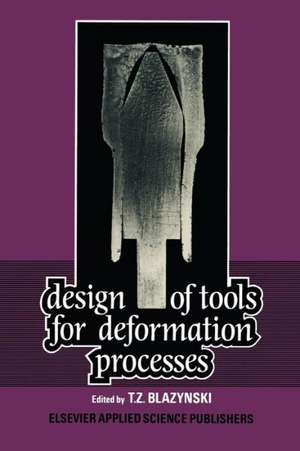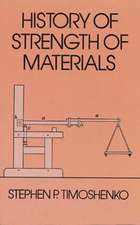Design of Tools for Deformation Processes
Autor T. Z. Blazynskien Limba Engleză Paperback – 13 oct 2011
Preț: 388.34 lei
Nou
Puncte Express: 583
Preț estimativ în valută:
74.31€ • 79.46$ • 61.96£
74.31€ • 79.46$ • 61.96£
Carte tipărită la comandă
Livrare economică 18 aprilie-02 mai
Preluare comenzi: 021 569.72.76
Specificații
ISBN-13: 9789401083553
ISBN-10: 940108355X
Pagini: 312
Ilustrații: XIV, 291 p. 13 illus.
Dimensiuni: 152 x 229 x 16 mm
Greutate: 0.42 kg
Ediția:Softcover reprint of the original 1st ed. 1986
Editura: SPRINGER NETHERLANDS
Colecția Springer
Locul publicării:Dordrecht, Netherlands
ISBN-10: 940108355X
Pagini: 312
Ilustrații: XIV, 291 p. 13 illus.
Dimensiuni: 152 x 229 x 16 mm
Greutate: 0.42 kg
Ediția:Softcover reprint of the original 1st ed. 1986
Editura: SPRINGER NETHERLANDS
Colecția Springer
Locul publicării:Dordrecht, Netherlands
Public țintă
ResearchCuprins
1. Concepts of Tool Design.- 1.1. Introduction.- 1.2. Pass Geometry and Product Quality.- 1.3. Empirical and Theoretical Bases for Design.- 1.4. Design Concepts and Their Effects.- References.- 2. Longitudinal and Oblique Rolling.- 2.1. Longitudinal Rolling: Hollow Sections.- 2.2. Roll Groove Design: Sinking and Stretch-Reducing Mills.- 2.3. Longitudinal Rolling: Bar and Rod.- 2.4. The Pilger Process: Rotary Forging.- 2.5. The Push Bench Process.- 2.6. The Diescher Mill: Elongation by Oblique Rolling.- 2.7. Expanding by Oblique Rolling.- 2.8. The Assel Mill: Oblique Elongating by Three Stepped Rolls.- 2.9. Three-Roll Planetary Rolling.- 2.10. Rotary Piercing.- References.- 3. The Drawing of Metals.- 3.1. Developments in the Drawing of Metals.- 3.2. Developments in Drawing Lubricants.- 3.3. Development of Tool Materials.- 3.4. The Mechanical Design of Draw Tools.- 3.5. Theoretical Considerations.- 3.6. Unusual and Recent Developments in Drawing.- References.- 4. Extrusion.- 4.1. Introduction.- 4.2. Design of Tools for Hot Extrusion.- 4.3. Industrial Practice in Tool Design.- 4.4. Theoretical Approaches and Limitations.- 4.5. Future Developments.- 4.6. Conform.- 4.7. Cold Extrusion of Steel.- 4.8. Cold Extrusion of Non-Ferrous Components.- 4.9. Hydrostatic, HERF and Other Extrusion Techniques.- References.- 5. Forging.- 5.1. Forging Process Variables Affecting Die Design and Manufacture.- 5.2. Importance of Forging Geometry and Shape Complexity.- 5.3. Design of Finisher Dies.- 5.4. Design of Blocker Dies.- 5.5. Computer-Aided Methods for Designing Forging Dies.- 5.6. Metal Flow Simulation for Optimizing Die Design.- 5.7. Manufacturing of Forging Dies.- 5.8. Dies for Special Forging Techniques.- References.- 6. Friction and Tools.- 6.1. Influence of Friction in Metal-Working.- 6.2. The Mechanics of Asperity Deformation.- 6.3. The Origin of Friction Stresses.- 6.4. Lubrication.- 6.5. Measurement of Friction.- 6.6. Friction and Normal Stress Distributions in Various Metal-Forming Processes.- 6.6.1. Upsetting.- References.- 7. Selection of Tool Materials.- 7.1. Introduction.- 7.2. Required Properties of Metal-Forming Tooling.- 7.3. Steels.- 7.4. Near Net Shape Tooling.- 7.5. Cemented Carbide.- 7.6. Ceramic and Ultra Hard Tool Materials.- 7.7. Titanium Carbide: High-Speed Steels.- 7.8. Surface Treatments and Coatings on Tool Materials.- 7.9. Concluding Remarks.- References.- 8. Computer Design.- 8.1. Introduction.- 8.2. Computer-Integrated Manufacturing.- 8.3. Computer-Aided Design: A Review.- 8.4. Computer-Aided Manufacture.- 8.5. Applications of Solid Modelling.- 8.6. Conclusion.- References.







